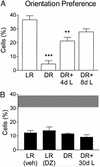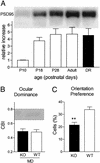Separable features of visual cortical plasticity revealed by N-methyl-D-aspartate receptor 2A signaling
- PMID: 12591944
- PMCID: PMC151430
- DOI: 10.1073/pnas.0536089100
Separable features of visual cortical plasticity revealed by N-methyl-D-aspartate receptor 2A signaling
Abstract
How individual receptive field properties are formed in the maturing sensory neocortex remains largely unknown. The shortening of N-methyl-d-aspartate (NMDA) receptor currents by 2A subunit (NR2A) insertion has been proposed to delimit the critical period for experience-dependent refinement of circuits in visual cortex. In mice engineered to maintain prolonged NMDA responses by targeted deletion of NR2A, the sensitivity to monocular deprivation was surprisingly weakened but restricted to the typical critical period and delayed normally by dark rearing from birth. Orientation preference instead failed to mature, occluding further effects of dark rearing. Interestingly, a full ocular dominance plasticity (but not orientation bias) was selectively restored by enhanced inhibition, reflecting an imbalanced excitation in the absence of NR2A. Many of the downstream pathways involved in NMDA signaling are coupled to the receptor through a variety of protein-protein interactions and adaptor molecules. To further investigate a mechanistic dissociation of receptive field properties in the developing visual system, mice carrying a targeted disruption of the NR2A-associated 95-kDa postsynaptic density (PSD95) scaffolding protein were analyzed. Although the development and plasticity of ocular dominance was unaffected, orientation preference again failed to mature in these mice. Taken together, our results demonstrate that the cellular basis generating individual sensory response properties is separable in the developing neocortex.
Figures





Similar articles
-
Developmental loss of miniature N-methyl-D-aspartate receptor currents in NR2A knockout mice.Proc Natl Acad Sci U S A. 2003 Feb 4;100(3):1340-5. doi: 10.1073/pnas.0335786100. Epub 2003 Jan 27. Proc Natl Acad Sci U S A. 2003. PMID: 12552130 Free PMC article.
-
Enhanced NR2A subunit expression and decreased NMDA receptor decay time at the onset of ocular dominance plasticity in the ferret.J Neurophysiol. 1999 May;81(5):2587-91. doi: 10.1152/jn.1999.81.5.2587. J Neurophysiol. 1999. PMID: 10322092
-
Co-regulation of ocular dominance plasticity and NMDA receptor subunit expression in glutamic acid decarboxylase-65 knock-out mice.J Physiol. 2009 Jun 15;587(Pt 12):2857-67. doi: 10.1113/jphysiol.2009.171215. Epub 2009 Apr 30. J Physiol. 2009. PMID: 19406876 Free PMC article.
-
Molecular basis of plasticity in the visual cortex.Trends Neurosci. 2003 Jul;26(7):369-78. doi: 10.1016/S0166-2236(03)00168-1. Trends Neurosci. 2003. PMID: 12850433 Review.
-
Do NMDA receptor kinetics regulate the end of critical periods of plasticity?Neuron. 2001 Nov 20;32(4):553-5. doi: 10.1016/s0896-6273(01)00514-1. Neuron. 2001. PMID: 11719195 Review.
Cited by
-
Otx2 binding to perineuronal nets persistently regulates plasticity in the mature visual cortex.J Neurosci. 2012 Jul 4;32(27):9429-37. doi: 10.1523/JNEUROSCI.0394-12.2012. J Neurosci. 2012. PMID: 22764251 Free PMC article.
-
Orthodenticle homeobox 2 is transported to lysosomes by nuclear budding vesicles.Nat Commun. 2023 Feb 27;14(1):1111. doi: 10.1038/s41467-023-36697-5. Nat Commun. 2023. PMID: 36849521 Free PMC article.
-
Identification of α-chimaerin as a candidate gene for critical period neuronal plasticity in cat and mouse visual cortex.BMC Neurosci. 2011 Jul 18;12:70. doi: 10.1186/1471-2202-12-70. BMC Neurosci. 2011. PMID: 21767388 Free PMC article.
-
Experience-dependent emergence of beta and gamma band oscillations in the primary visual cortex during the critical period.Sci Rep. 2015 Dec 9;5:17847. doi: 10.1038/srep17847. Sci Rep. 2015. PMID: 26648548 Free PMC article.
-
A specialized NMDA receptor function in layer 5 recurrent microcircuitry of the adult rat prefrontal cortex.Proc Natl Acad Sci U S A. 2008 Oct 28;105(43):16791-6. doi: 10.1073/pnas.0804318105. Epub 2008 Oct 15. Proc Natl Acad Sci U S A. 2008. PMID: 18922773 Free PMC article.
References
Publication types
MeSH terms
Substances
LinkOut - more resources
Full Text Sources
Molecular Biology Databases

